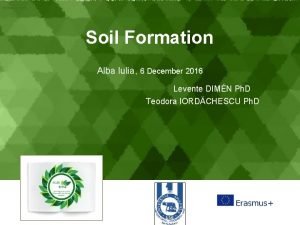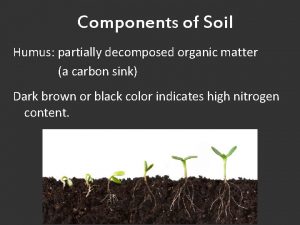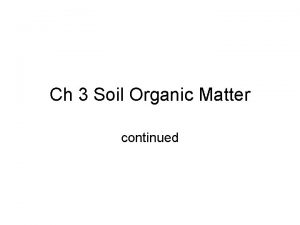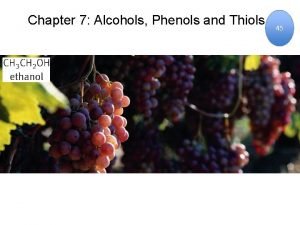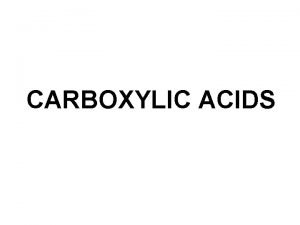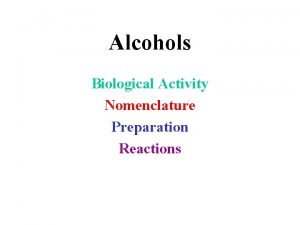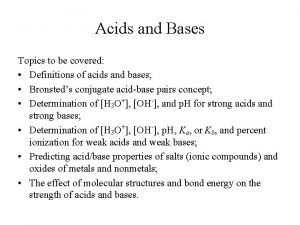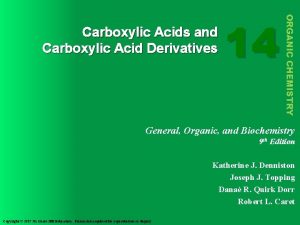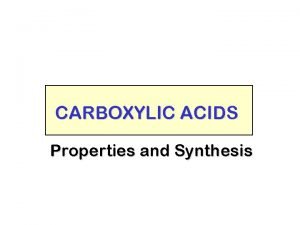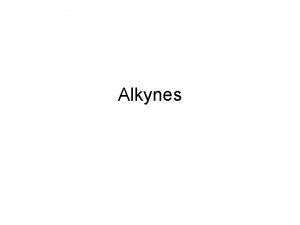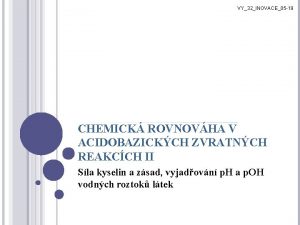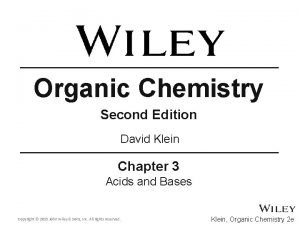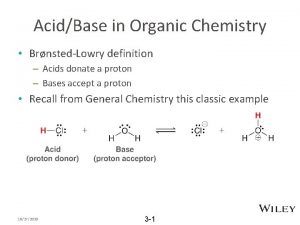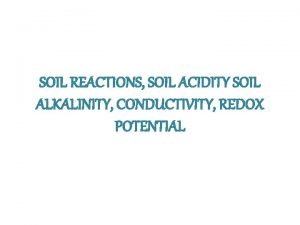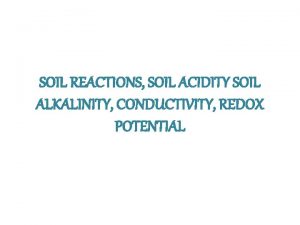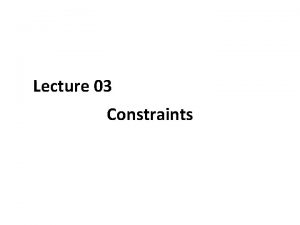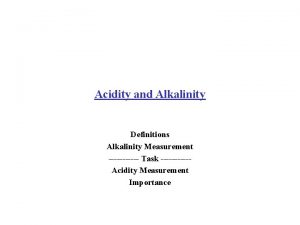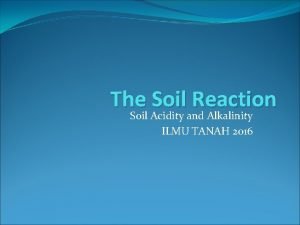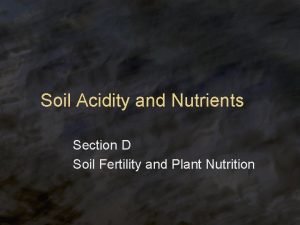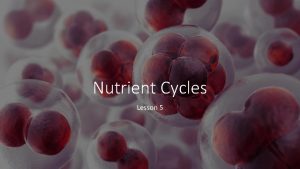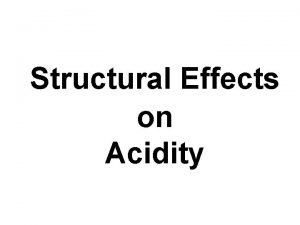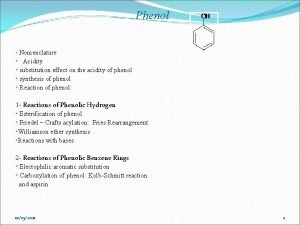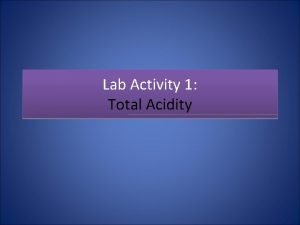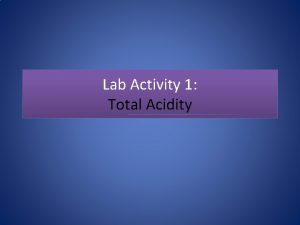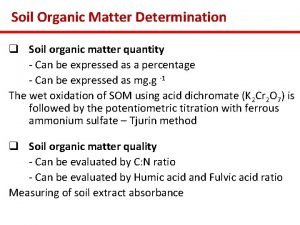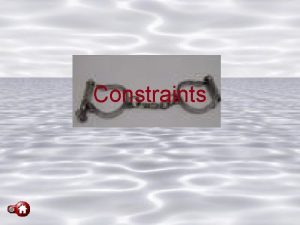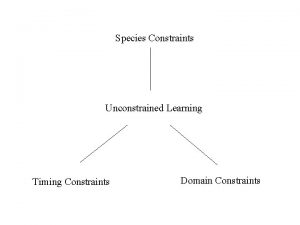Acidity and nutrient constraints on the soil organic



















- Slides: 19

Acidity and nutrient constraints on the soil organic matter balance Field experiments with artificial additions of mineral S and N to spruce and beech forests Filip Oulehle, Karolína Tahovská, Jiří Bárta, Michal Růžek, Martin Šimeček, Oldřich Myška Project founded by:

Temporal trends of sulfur and nitrogen depositions across the Europe Some unexpected effects of declining acid deposition on C and N cycling in Czech forests. ACID RAIN 2015 | OCTOBER 19 -23, 2015 | ROCHESTER, NY, USA

Recovery from acidification affected: 1. Productivity of mountain forests Kolář, T. et al. Pollution control enhanced spruce growth in the "Black Triangle" near the Czech-Polish border (2015) Science of the Total Environment, 538, art. no. 18295, pp. 703 -711 2. Nitrate leaching from forested watersheds (GEOMON network; N=14) 50% 20% 3. Dissolved organic carbon (DOC) leaching from forested watersheds Hruška, J. et al. Changes in soil dissolved organic carbon affect reconstructed history and projected future trends in surface water acidification (2014) Water, Air, and Soil Pollution, 225 (7), art. no. 2015, 30% 4. Forest floor carbon pool 35% Oulehle, F. Major changes in forest carbon and nitrogen cycling caused by declining sulphur deposition (2011) Global Change Biology, 17 (10), pp. 31153129. ACID RAIN 2015 | OCTOBER 19 -23, 2015 | ROCHESTER, NY, USA

Thus, new field experimental study was initiated to address the following general objectives: 1) To quantify the effect of acidity/N availability changes on the amount of C and N lost from the forest soil via organic (DOC, DON - dissolved organic nitrogen) and inorganic (NO 3, CO 2) pathways, in two major forest types. 2) To measure how acidity/N availability affects a range of key internal N and C transformations; decomposition of SOM - net nitrogen mineralisation and nitrification, gross mineralization, nitrification and immobilization, microbial respiration and activity of key enzymes involved in C, N, S and P cycling. 3) To measure how acidity/N availability affects the composition of decomposer communities in forest floor (qualitative and quantitative assessment of fungal and bacterial communities). Soil fluxes Soil processes Soil biology ACID RAIN 2015 | OCTOBER 19 -23, 2015 | ROCHESTER, NY, USA

Experimental sites and methods: 780 m; 1000 mm; 6°C Where: Spruce forest (80 years) Beech forest (120 years) ACID RAIN 2015 | OCTOBER 19 -23, 2015 | ROCHESTER, NY, USA

Experimental sites and methods: Monthly addition Ctrl Acid treatment (H 2 SO 4; 50 kg S/ha/yr) Nitrogen treatment (NH 4 NO 3; 50 kg N/ha/yr) Combined treatment (N+S) 2013 Pre-treatment 2014 2015 2016 Treatment year ACID RAIN 2015 | OCTOBER 19 -23, 2015 | ROCHESTER, NY, USA

Preliminary results – Field measurements Forest floor Soil water chemistry Mineral soil (30 cm depth) Treatment effect on soil solution p. H Forest floor Since 2014 forest floor soil solution p. H has been decreasing in acid treatments (p. H=3. 4). Ctrl and N treatments p. H = 3. 7. No change in soil solution p. H in the mineral soil yet. Mineral soil Since 2014 forest floor soil solution p. H has been decreasing in acid treatments (p. H=3. 7). Ctrl and N treatments p. H = 4. 1. Mineral soil No change in soil solution p. H (2014), since 2015 decrease to 4. 5 in acid treatments. ACID RAIN 2015 | OCTOBER 19 -23, 2015 | ROCHESTER, NY, USA

Preliminary results – Field measurements Forest floor Soil water chemistry Mineral soil (30 cm depth) Treatment effect on soil solution DOC Forest floor Since 2014 forest floor soil solution DOC decreased by ≈20% in acid treatments compared to Ctrl. No change in soil solution DOC in the mineral soil yet. Mineral soil Forest floor Since 2014 forest floor soil solution DOC decreased by ≈40% acid treatments and by ≈20% in N. Mineral soil No change in soil solution DOC since 2014 in the mineral soil. ACID RAIN 2015 | OCTOBER 19 -23, 2015 | ROCHESTER, NY, USA

Preliminary results – Field measurements Forest floor Soil water chemistry Mineral soil (30 cm depth) Treatment effect on soil solution DOC quality (DOC/DON; SUVA) Forest floor No change in the DOC/DON ratio yet No change in SUVA yet. Mineral soil Forest floor No change in the DOC/DON ratio yet Mineral soil Lower forest floor SUVA in acid treatments (by ca 10%) – less aromatic/hydrophobic ACID RAIN 2015 | OCTOBER 19 -23, 2015 | ROCHESTER, NY, USA

Preliminary results – Field measurements Forest floor Soil water chemistry Mineral soil (30 cm depth) Treatment effect on soil solution NO 3 Forest floor Higher NO 3 leaching in N treatments in forest floor, still rather high immobilization (80%). High inorganic N immobilization in the mineral soil (98%) Mineral soil Forest floor Higher NO 3 leaching in N treatments in forest floor, still high immobilization (90%). Mineral soil High inorganic N immobilization in the mineral soil (95%) ACID RAIN 2015 | OCTOBER 19 -23, 2015 | ROCHESTER, NY, USA

Preliminary results – Field measurements Survey chamber (monthly April-November) Soil respiration - 4 measurements per plot – 64 per site - high spatial resolution Long-term chambers (May, Jul, Sep, Nov) - 16 continuous 48 hours measurements per site - high temporal resolution (day vs. night) Treatment effect on total soil respiration (survey chamber) Higher (≈ 10 %) total soil respiration in N only treatment, whereas lower in S only treatment (≈ 10 %) Total soil respiration in S only treatment lower by 10% Strong temperature dependence ACID RAIN 2015 | OCTOBER 19 -23, 2015 | ROCHESTER, NY, USA

Preliminary results – Field measurements Survey chamber (monthly April-November) Soil respiration - 4 measurements per plot – 64 per site - high spatial resolution Long-term chambers (May, Jul, Sep, Nov) - 16 continuous 48 hours measurements per site - high temporal resolution (day vs. night) Treatment effect on total soil respiration (long-term chamber) Strong temperature dependence S only treatment generally lower by 15% compared to Ctrl However, extremely hot and dry 2015 caused variability increase across treated plots. The reason is unclear. . . before/after the onset of photosysnthesis ACID RAIN 2015 | OCTOBER 19 -23, 2015 | ROCHESTER, NY, USA

Preliminary results – Laboratory work Community composition – yet only 2013 data – site comparison Bacteria – alpha-diversity (observed species per 4500 seqs) BEECH SPRUCE Fungi – alpha-diversity (observed species per 600 seqs) BEECH SPRUCE ACID RAIN 2015 | OCTOBER 19 -23, 2015 | ROCHESTER, NY, USA

Preliminary results – Laboratory work Community composition Treatment effect on fungi to bacteria ratio ACID RAIN 2015 | OCTOBER 19 -23, 2015 | ROCHESTER, NY, USA

Preliminary results – Laboratory work Community composition Treatment effect on microbial biomass C and N N treatments stimulated C and N accumulation in the microbial biomass in the forest floor. Forest floor microbial C/N = 10 No apparent changes in C microbial biomass, inconsistent changes in N microbial biomass. Forest floor microbial C/N = 10 ACID RAIN 2015 | OCTOBER 19 -23, 2015 | ROCHESTER, NY, USA

Preliminary results – Laboratory work Processes C Beta-glucosidase (BG) Cellobiosidase (CEL) P Phosphatase (PME) Leucin-Aminopeptidase (LEU) N N-Acetylglucosaminidase (NAG) Treatment effect on key enzyme activities involved in C, P and N cycling All treatments stimulated C enzymes and P enzymes in 2015. No clear effects of the treatments on enzyme activities yet. ACID RAIN 2015 | OCTOBER 19 -23, 2015 | ROCHESTER, NY, USA

Preliminary results – Laboratory work Processes Treatment effect on net N amonification and nitrification in the forest floor Reduced amonification under S treatments and enhanced under N treatment compared to Ctrl. No clear trend in net amonification ACID RAIN 2015 | OCTOBER 19 -23, 2015 | ROCHESTER, NY, USA

Preliminary results – Laboratory work Processes Treatment effect on microbial heterothrophic respiration Reduced heterothrophic respiration under N treatments compared to Ctrl. Reduced heterothrophic respiration under combined S+N treatment compared to Ctrl. Whereas enhanced under N only and S only treatments. ACID RAIN 2015 | OCTOBER 19 -23, 2015 | ROCHESTER, NY, USA

Concluding remarks 1. Strong p. H effect on DOC and DON concentrations in the forest floor soil solution. - More pronounced DOC change in beech (40% decrease) compared to spruce (20% decrease). Less aromatic/hydrophobic DOC in acid treatments (especially in the beech forest). - DOC more sensitive to quantity/quality change by higher p. H (less protonated carboxyl groups)? Unexpected DOC decrease in N only treatment in the beech forest Delayed treatment effects on the soil solution chemistry in the mineral soil. 2. NO 3 leaching in N treatments, still high immobilization of added N. Limited leaching into the mineral soil. 3. S only treatment caused consistent decrease of the soil respiration (by ≈ 10 %) in both forest types. In the spruce forest N treatment stimulated soil respiration by 10 %. No change in S+N treatment – result of the opposite effects of the S and N treatments? 4. Soil respiration strongly related to the soil temperature. - However, soil moisture critical. Dry condition coupled with vegetation season in beech forest caused unexpected variation in the soil respiration. On average doubled soil respiration fluxes during hot and dry season 2015. - Importance of the autothrophic part of the soil respiration or/and hydraulic water uplift from deeper soil. 5. Higher bacteria diversity in the beech forest, similar fungi diversity. Clear functional differences between both forests. However, both forests have similar microbial biomass C/N. - N treatments in the spruce forest stimulated C and N in the microbial biomass. Consistent with respiration measurements. 6. All treatments in the spruce forest stimulated C enzyme activities. No change in the beech forest. - Digging for energy – less C in acid treatments, higher demand by microbes in N treatment? 7. S treatments had negative effect on net amonification, whereas N treatment had positive effect in spruce stand. No apparent changes in net mineralization in the beech stand. Anyhow, high variability Clear responses on the ecosystem scale (soil solution chemistry, respiration), less clear responses on the microbial scale. However, might change completely within next couple of years. . . ACID RAIN 2015 | OCTOBER 19 -23, 2015 | ROCHESTER, NY, USA
 Agar
Agar Soil science simplified
Soil science simplified Mineral vs organic soil
Mineral vs organic soil Partially decomposed organic matter in the soil is
Partially decomposed organic matter in the soil is Ultisoils
Ultisoils Csiro.au
Csiro.au Nomenclature of ether
Nomenclature of ether Ester to carboxylic acid
Ester to carboxylic acid Na2cr2o7 mechanism
Na2cr2o7 mechanism Sp
Sp Acid base trends
Acid base trends Acidity of thiols
Acidity of thiols Carboxylic acid with base
Carboxylic acid with base Periodic trends acidity
Periodic trends acidity 3 methylbutanoic acid
3 methylbutanoic acid Effect of hybridization on acidity
Effect of hybridization on acidity Acidity of phenol
Acidity of phenol Iontový součin vody
Iontový součin vody Qualitative organic analysis
Qualitative organic analysis Ario acidity
Ario acidity


